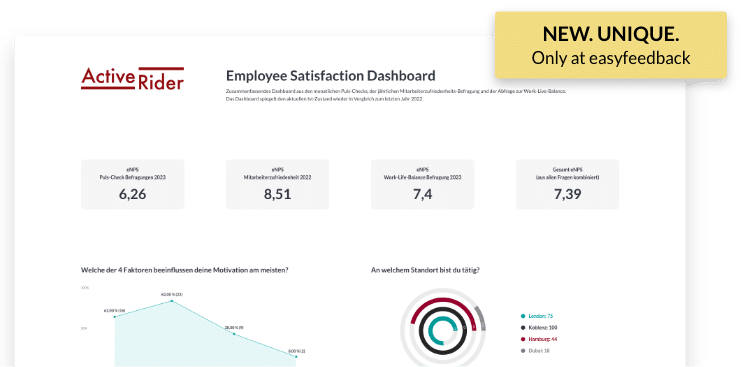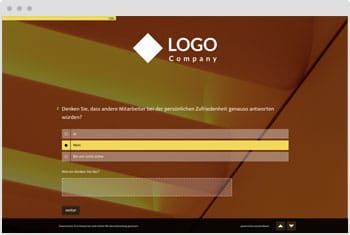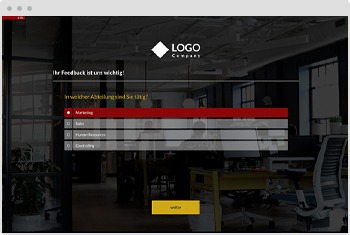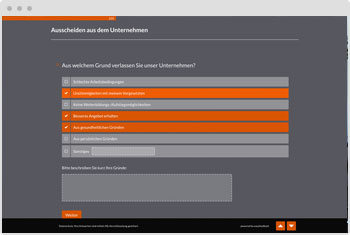Get continuous insight into the workload of your employees with a pulse survey

With this ready-to-use survey template, you can gain insight into employee workload, stress and satisfaction through brief and regular feedback.

“Identifying customer needs is an essential part of our business. easyfeedback accompanies us for many years as a loyal partner in this task. We particularly appreciate the intuitive usability of the survey tool as well as the professional support.”
Franziska Becker
Guild Lead User Experience Research

“We use easyfeedback for internal and external surveys – fast, comfortable and really easy! Straightforward and cordial support can always create a smile. We really appreciate the permanent development of the platform.”
Guest & Competitor Insights Analyst
Content and targets of this pulse check template
Simple, short feedbacks give you continuous insight into your employees’ workload. Identify if workloads may be too high.
Projects can quickly increase pressure when deadlines are tight. In addition, too much workload can lead to mental stress and illness .
Short employee surveys can be done weekly or monthly. Gain insight into workload and project status via pulse checks. Detect undesirable developments early enough for simple countermeasures.
Use our ready-to-use template for a short pulse check survey of your employees. The questionnaire takes very little time and provides you with important insights into general well-being, workload and employee satisfaction.
Content:
• General well-being and satisfaction
• Emotional workload
• Workload and time management
• Recognizing emerging overload
Targets:
• Simple, brief feedback on day-to-day work life
• Observing the workload
• Observation of satisfaction in projects
• Connections between project status and workloads

Data privacy protection „made in Germany“ (GDPR)

Anonymity functions for open feedback
Almost everything you need to know about pulse check surveys
1. What is a pulse check?
A pulse check is a survey instrument with which you can quickly and easily determine the satisfaction of your workforce. By means of a short questionnaire consisting of a maximum of 5-10 specific questions, which is carried out at regular intervals, you receive continuous feedback on the workload, stress and satisfaction of your employees. In this respect, the pulse check survey serves as a mood barometer within your company.
2. Why should you conduct a pulse survey? What are the goals?
The aim of a pulse survey is to measure the motivation and satisfaction of your employees. Based on the data collected, you can better assess the current workload and the working atmosphere. Possible undesirable developments can be identified early enough to take countermeasures. It also enables you to measure process progress and teamwork. This results in concrete potential for improvement, which you can address.
Regular employee surveys involve your workforce, giving them the opportunity to make a significant contribution to the company’s success. This also promotes employee motivation and loyalty to the company.
3. What are the advantages of a pulse survey?
Conducting a pulse survey takes little time. The quick and timely feedback provides you with valuable information about the work climate and workload of your employees. In addition, negative trends become visible through a continuous pulse survey. This enables you to react quickly, initiate appropriate countermeasures and make adjustments if necessary. As a result, you can save time and money. Furthermore, you actively involve your employees and thus show them your appreciation.
4. When and how often should I conduct a pulse check employee survey?
Pulse check surveys should be carried out continuously and at fixed intervals. A weekly or monthly rhythm has proven effective here. They are a good instrument, for example, after restructuring processes within the company, in order to obtain immediate feedback on the change and to readjust if necessary.
They are also useful if there is no time for a detailed employee survey or if you want to check the workload during the processing of projects in order to identify undesirable developments at an early stage.
5. What are the phases of the pulse survey?
The pulse survey consists of three phases: Preparation, implementation and evaluation. In the preparation phase, you create an online questionnaire with easyfeedback, for example. In the next phase, you have your employees answer it and evaluate the questionnaire in the third phase. The collected results contribute to the optimization of your company and give you important clues for potential improvements and new approaches.
6. How do I design a pulse survey? What questions can I ask employees?
Generally, the following applies: Design the pulse employee survey in a clear and structured manner. Limit yourself to the most important questions. Consider in advance which areas you would like to cover with the survey. If you have carried out a restructuring, it may make sense to ask about employees’ experiences in this regard; or if you would like to ask about the current status of a specific project, then direct your questions in this direction.
Possible questions might be:
- Has the restructuring helped improve workflow?
- What is the current workload?
- Do you feel comfortable working with your team?
- Do you identify with the company?
- How is your relationship with your supervisor?
- How happy are you with your current job?
7. Are there any tips for the pulse check survey?
Below we have prepared a few tips for you on how to design and conduct your pulse check survey.
1. Focus on relevant content.
Which topics are important for your company? Has any restructuring been carried out? What is the current workload?
2. Keep the survey short.
Ask a maximum of 5-10 specific questions to ensure that your employees are fully engaged and complete the pulse survey.
3. Pay attention to anonymity and data protection.
Only if the anonymity of your employees is preserved can you expect honest and unbiased responses. Moreover, if your employees do not have to fear any negative consequences, their willingness to participate in the survey will increase.
4. Inform your employees about the results.
Involve your employees and encourage them to communicate openly.
5. Repeat the pulse surveys at regular intervals.
For example, perform the pulse check weekly or monthly to keep an eye on the mood in your company and to be able to react quickly to possible changes.
6. Make periodic adjustments to the pulse surveys.
Are the topics still current? Are there any other topics that should be included?
7. Do not take negative feedback personally.
Use it as a starting point for further optimization.
You are in professional company







easyfeedback welcomes more than 740.000 participants per month!







